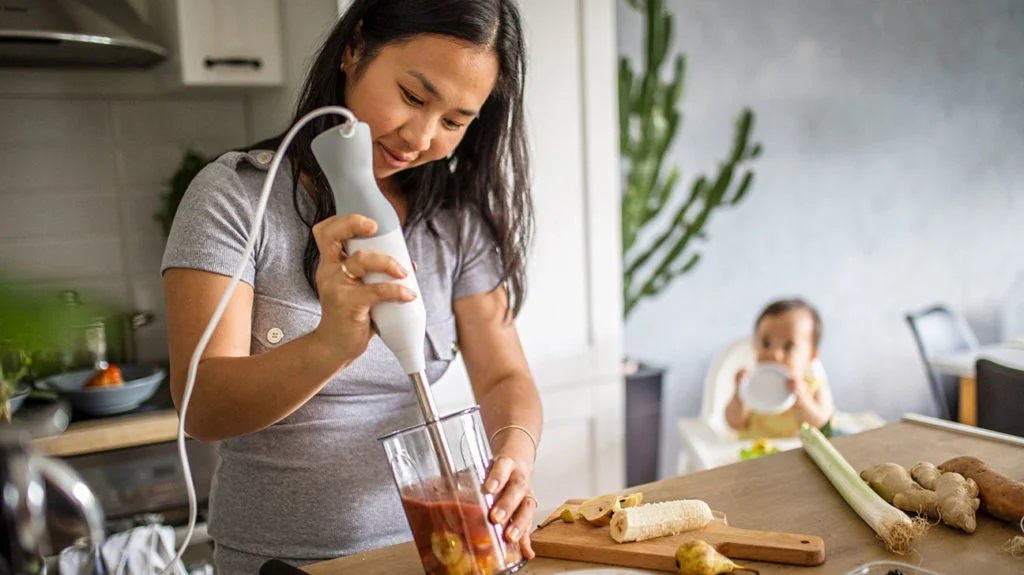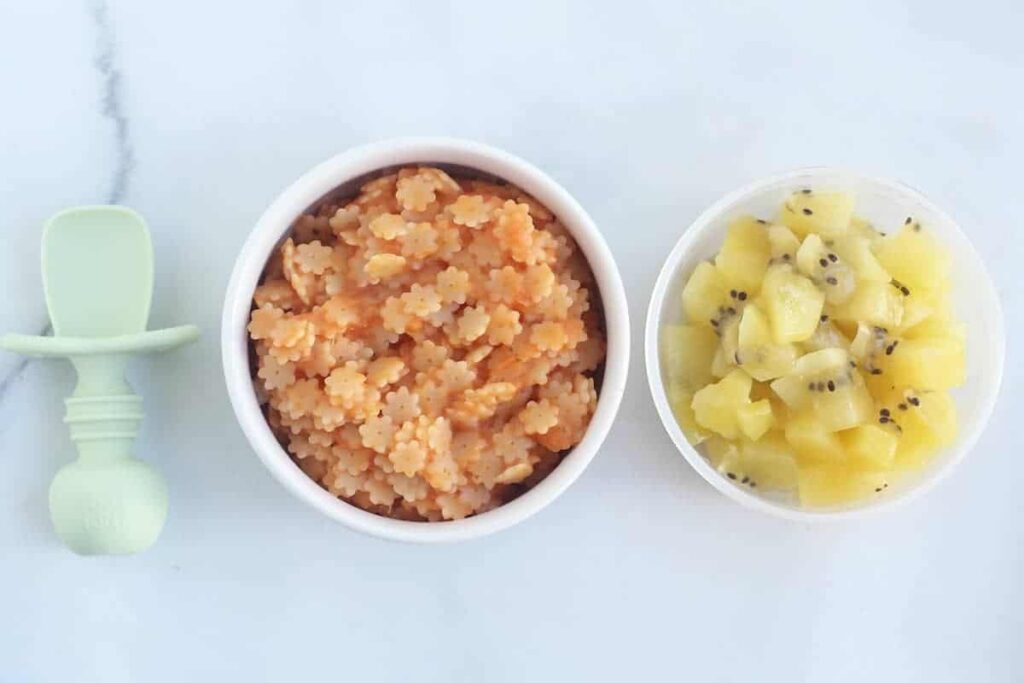Intro

Are you a new or expecting mother wondering what baby-led weaning is all about?
If so, you’re in the right place!
In this blog post, we will explore the exciting journey of baby-led weaning, from understanding the basics to overcoming common challenges.
Get ready to embark on a wonderful adventure with your baby as they lead the way in their weaning journey.
What is baby-led weaning?
Let’s find out!
Understanding the Basics of Baby-Led Weaning

Baby-led weaning represents a significant shift from traditional weaning methods, putting your baby at the helm of their eating adventures.
This approach diverges from spoon-fed purees, inviting your baby to engage directly with a variety of finger foods.
It’s all about letting them grasp, gnaw, and self-feed, turning mealtime into a discovery zone.
Through this process, your baby exercises autonomy, learning to listen to their hunger and fullness cues, which is vital for developing healthy eating patterns.
Imagine mealtime as a playground for taste and texture, where your baby is both the explorer and the decider.
They’ll squish, smell, and sometimes smush food between their fingers before deciding to taste it.
This hands-on exploration is not just about eating; it’s an educational journey that bolsters fine motor development and sensory experiences.
Choosing the right foods is crucial in this weaning method.
The goal is to offer soft, easily manageable pieces that your baby can handle confidently.
Think ripe fruits, steamed vegetables, and tender cuts of meat.
These foods should be safe for your baby to explore without immediate supervision but always under a watchful eye to ensure safety.
Embracing baby-led weaning is embracing a learning curve – your baby’s curiosity is the driver, and your support is the guide.
As they navigate this new world of solid foods, your role is to provide a varied, nutritious menu that invites exploration and celebrates each milestone on their weaning journey.
The Benefits of Letting Your Baby Lead the Way

The journey of baby-led weaning is not just about introducing solid foods; it’s about nurturing a bundle of life skills wrapped in exciting mealtime adventures.
This approach encourages your little ones to engage directly with their food, allowing them to touch, taste, and explore a variety of textures and flavors at their own pace.
The freedom to interact with their meals fosters an incredible sense of autonomy and confidence, promoting a healthy relationship with food from the earliest bites.
By taking the lead, babies learn to regulate their appetite effectively, eating until they are satisfied rather than when the spoon decides they’re done.
This self-regulation is a cornerstone of developing healthy eating habits that can last a lifetime.
Moreover, navigating the complexities of picking up foods and guiding them to their mouths enhances their hand-eye coordination, a skill that transcends the high chair.
Perhaps one of the most delightful benefits of baby-led weaning is the potential to broaden a child’s palate and reduce picky eating behaviors.
By offering a spectrum of wholesome foods, babies get the chance to discover preferences and enjoy a varied diet, paving the way for a lifelong appreciation of nutritious food choices.
In essence, baby-led weaning goes beyond feeding.
It crafts a foundation for independence, mindful eating, and a positive food journey that both you and your baby will cherish.
Getting Started with Baby-Led Weaning: Tips for Success

Embarking on the baby-led weaning journey is an exhilarating time for both you and your baby, filled with exploration and discovery.
To ensure a smooth start, focus on introducing soft, easy-to-hold foods that your little one can explore with their hands and gums.
Begin with simple, single-ingredient offerings like ripe avocado slices, steamed carrot sticks, or soft-cooked apple wedges.
These choices are not only nutritious but also manageable for tiny hands to navigate.
Creating a relaxed, distraction-free dining environment encourages your baby to focus on the sensory experience of eating.
Join them at the table, making mealtime a shared, social activity.
This not only fosters a positive association with food but also models healthy eating behaviors.
As you observe your baby’s cues and reactions, resist the urge to intervene too quickly.
Allow them the space to experiment, even if it means they play with their food more than they eat it initially.
Remember, baby-led weaning is as much about developing motor skills and independence as it is about nutrition.
Lastly, always prioritize safety.
Ensure foods are appropriately sized to reduce choking risks and supervise your baby closely during meals.
With patience, encouragement, and a dash of humor for the inevitable messes, you’ll find that these early steps in baby-led weaning lay the groundwork for a lifetime of adventurous, joyful eating.
Overcoming Common Challenges in Baby-Led Weaning

Navigating the hurdles of baby-led weaning is a part of the adventure, bringing its own set of challenges that can sometimes feel daunting.
Gagging, for instance, is a common concern among parents.
It’s a natural reflex that helps babies learn to manage solids, but distinguishing it from choking is crucial for peace of mind.
Remember, gagging is often noisy and active; choking is silent and requires immediate action.
Embrace the messiness of mealtimes as a sign of exploration and learning rather than a nuisance.
Use this as an opportunity to teach your baby about different textures and the joys of self-feeding, even if it means a bit more cleanup afterward.
Another concern is ensuring your baby receives adequate nutrition without traditional purees.
Offering a wide range of nutrient-rich foods will help meet their dietary needs as they gradually improve their eating skills.
Patience is key.
It’s important to go at your baby’s pace and allow them the space to explore, taste, and sometimes reject new foods.
This process helps them build confidence and curiosity about food.
Lastly, always stay vigilant about potential choking hazards.
Opt for soft, easily mashable foods that your baby can handle safely.
If you’re ever in doubt, consult a pediatric healthcare provider for guidance.
With understanding, patience, and a supportive approach, you can smoothly navigate these challenges and enjoy the rewarding journey of baby-led weaning together.
Baby-Led Weaning Myths vs. Facts

Navigating through the sea of baby-led weaning information, it’s easy to stumble upon myths that might deter or confuse many.
One common misconception is the belief that babies are unable to manage solid foods without a full set of teeth.
However, their gums are surprisingly strong, capable of mashing soft foods effectively.
Another widespread myth is the fear that baby-led weaning leads to nutritional deficiencies.
In truth, as long as a diverse array of wholesome, nutrient-dense foods is offered, babies can receive all the essential nutrients they need for healthy development.
Some also worry that this method increases the risk of choking, but when foods are prepared safely and babies are supervised, the risk is no greater than with traditional weaning methods.
It’s essential to distinguish fact from fiction to approach baby-led weaning with confidence and clarity, ensuring your little one embarks on a nutritious, enjoyable, and safe eating adventure.
Supporting Your Baby’s Weaning Journey: Do’s and Don’ts

To foster a joyful and successful baby-led weaning experience, it’s crucial to embrace some key do’s and don’ts.
Do encourage a rainbow of nutrient-dense foods at your baby’s fingertips, allowing them to explore tastes and textures in a secure environment.
Variety is the spice of life, and in this case, it’s also the foundation of a nutritious diet.
Ensure that mealtimes are peaceful, undistracted occasions where your little one can fully engage with the sensory aspects of food.
Observing you eat and enjoy the same foods can inspire their curiosity and willingness to try new things.
On the flip side, avoid rushing your baby through meals or expecting immediate mastery.
Patience is your best ally as your baby learns at their own pace.
Similarly, don’t pressure them into eating; this is their journey to navigate with your guidance, not direction.
Steer clear of offering foods that pose choking risks; safety is paramount.
Small, manageable pieces are the way to go, ensuring a safe exploration of solids.
By keeping these guidelines in mind, you’ll provide an empowering environment that nurtures your baby’s independence and makes mealtimes a positive, enriching experience.
When to Seek Advice: Baby-Led Weaning Concerns

If your journey with baby-led weaning brings up questions or concerns, such as ongoing gagging, a lack of interest in food, or discomfort during meals, reaching out to a healthcare professional is a wise step.
They can offer you personalized advice, assurance, and the extra support you may need to navigate these hurdles successfully.
It’s crucial to remember that each little one’s path to solid foods is as unique as they are.
Therefore, if something feels off or you’re unsure about your baby’s progress, don’t hesitate to seek out expert guidance.
A pediatrician or a feeding specialist can provide valuable insights, helping you adjust your approach to meet your baby’s individual needs and ensure their weaning journey is both joyful and beneficial.
